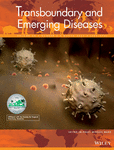Temporal and spatial distribution trends of human brucellosis in Liaoning Province, China
Qi Zhang, Chunlin Li, Ying Wang, and Ye Li contributed equally to this work.
Abstract
Brucellosis is a natural epidemic zoonotic disease. Liaoning province, north-east of China, has been among the top 10 provinces with highest brucellosis incidence. In this study, the spatial and temporal distribution of brucellosis in Liaoning Province from 2006 through 2017 was analysed using the Bayesian theory of space–time modelling. The study found that in Liaoning Province, (a) all regions of the entire study area were stable counties; (b) the risk of brucellosis declined slowly with time without an obvious trend; (c) the declining trend of disease risk in three sub-hot-spot counties was faster than the overall trend, whereas in other counties, the trend was similar to the overall trend. Furthermore, the time and spatial trends of brucellosis incidence in Liaoning Province were calculated and analysed. These results may provide a theoretical and scientific basis for the public health department to develop targeted effective prevention and control measures for the disease.
1 INTRODUCTION
Brucellosis is a natural epidemic zoonosis and an infectious-allergic disease caused by Brucella (Pakzad et al., 2018). It causes serious health and economic burdens around the world (Zhong et al., 2013). Brucella is primarily transmitted between animals or from animals to humans, and there are a few reports of human-to-human transmission (Sun, Mao, LI, Sun, & Yao, 2012). The primary agents of infection in humans are B. abortus (cattle) and B. melitensis (sheep and goats; Abdullayev et al., 2012; Roth et al., 2003). Humans acquire the infection when they come in contact with infected animals or contaminated animal products, especially under-cooked goat's milk or cheese (Franco, Mulder, Gilman, & Smits, 2007; Pappas, Akritidis, Bosilkovski, & Tsianos, 2005). Occasionally, inhalation of infectious aerosols carrying Brucella may cause brucellosis, a primary source of laboratory-acquired infections. The disease first appeared in China in 1905 (Franco et al., 2007) and was confirmed by serological methods in 1916(Pappas, Papadimitriou, Akritidis, Christou, & Tsianos, 2006). In 1925, the pathogen was isolated and diagnosed as human brucellosis. The incidence rate was fairly high before the 1980s and then declined (Shang, Xiao, & Yin, 2002).
In Liaoning Province, mainly sporadic cases of brucellosis have been reported since 1957. In 1989, it reached the national disease control standard, and in 1994, there was an outbreak in some counties of Liaoning Province. After reaching the peak in 2004, it briefly fell back. However, the number of reported cases has increased year by year since 2007, and the epidemic situation has rebounded (Sun, Zhao, & Wang, 1998; Sun et al., 2017; Wang, Yu, Mao, Sun, & Yao, 2018). The increasing number of brucellosis cases in humans each year has caused a major social and economic burden on humans and animal husbandry. According to national statistics, Liaoning Province has always been in the forefront in terms of the number of animal husbandry and they continue to increase. The increased number of animal husbandry and livestock trade (import and export) will further increase the risk of spreading brucellosis in Liaoning Province.
Several studies have predicted the incidence of brucellosis by analysing the genotype, serotype or time distribution of data (Guan, Wu, & Huang, 2018; Piao et al., 2018; Ran et al., 2018). It appears that the location and time are two important factors in the distribution of a disease. Some studies have analysed the distribution of scrub typhus disease and hand–foot–mouth disease (Zhang et al., 2017; Zhu, Hao, & Yu, 2011). The dynamic trend of the disease and the trend over time can be predicted by analysing the location and time (Carrel, Emch, Streatfield, & Yunus, 2009; Clennon et al., 2004). Therefore, our study analysed the time and spatial information of the cases of brucellosis through Bayesian theory-based space–time analysis. The study aims were (a) to examine the distribution of brucellosis from 2006 to 2017 in Liaoning Province; (b) to identify the high-risk and low-risk areas in Liaoning Province; and (c) to assess the time trends for the occurrence of brucellosis. The results may contribute to appropriate decision-making and accurate targeting of health interventions.
2 MATERIAL AND METHODS
2.1 Study area
Liaoning is a northeastern Chinese province, covering an area of 148,600 km2 with a population of over 43 million in 2017. The province has a variety of environmental conditions in terms of geography and topographic diversity, such as mountains, hills and plains. Liaoning Province has a monsoon climate of medium latitudes, with an annual rainfall range of 600–1,100 mm/year, and the temperature ranges between −20°C and 38°C. Liaoning is bordered by the Yellow sea and Bohai to the south, Hebei Province to the south-west, Inner Mongolia to the north-west, Jilin Province to the north-east and by North Korea via the Yalu River.
2.2 Data collection
 (1)
(1)2.3 ArcGIS analysis
The most recently updated electronic map of Liaoning Province and its county scale was used for ArcGIS analysis, and the map was linked to Excel. The average annual incidence distribution map of Liaoning Province was produced at the county scale, using a colour range to show changes in the layers of polygons. The risk change analysis of human brucellosis in Liaoning was based on the analysis of the Bayesian space–time model of the WinBUGS software.
2.4 Bayesian space–time model
Bayesian spatiotemporal model is a mathematical model established to analyse the temporal and spatial information contained in the spatiotemporal data under the framework of Bayesian statistical thought, which is an extension of the spatial model (Bernardinelli et al., 1995; Bohning et al., 2000).The specific model was divided into three levels (Chen, Liao, Zhang, & Xu, 2017):
2.4.1 Data model

2.4.2 Process model
 (2)
(2)2.4.3 Parameter model
The spatial structure effect was defined by the conditional autoregressive (CAR) prior structure according to the BYM model (Besag, York, & Mollié, 1991). In this process, a spatial adjacency weight matrix needed to be defined. The weight adjacency was wij = 1, otherwise the weight wij = 0, and the special wii = 0. Similarly, b1i was assumed to follow the BYM process. For the time structure effect υt, a CAR process was also used to fit, and the adjacent weight matrix in time was similarly defined. The over-discrete parameter, εit, followed a normal distribution with a mean of 0 and a variance of  . The variance of each parameter was usually assumed to obey Gamma (a, b).
. The variance of each parameter was usually assumed to obey Gamma (a, b).
Based on the model, through the spatial component si and its posterior probability, high-risk or low-risk counties with the average risk (α) of the entire study area were identified. By calculating the probability of spatial relative risk, the probability that exp(si) was bigger than 1 and divided into five categories: the districts with probabilities >.8, .6–.8, .4–.6, .2–.4 and <.2 were defined as hot-spot counties, sub-hot-spot counties, stable counties, sub-cold-spot counties and cold-spot counties, respectively. Similarly, based on the probability threshold, it was possible to identify the differences of these classification regions based on the change trend of the entire time. The probability of exp(b1i) bigger than 1 was divided into five categories: the counties with the incidence risk probability bigger than .8 showed a rapid change trend relative to the overall risk change; between .6 and .8 showed that the incidence risk had a slightly faster changing trend than the overall risk change; between .4 and .6 were considered to have the same incidence risk as the overall risk change trend; between .2 and .4 were considered to have a slower declining trend than the overall risk change; and the counties with a probability less than .2 were considered to have an obvious declining tendency compared with the overall risk change.
3 RESULTS
All case data are statistically analysed and compared in terms of age, gender, season and occupation. The highest incidence rate was in the 45–54 years age group, and the median age of the patients was 49 years old and the annual incidence rate was higher (Table 1). Brucellosis incidence in males was 3.07 times than that in women. The high-incidence months in 2006–2017 are relatively concentrated, mainly from March to June, and the incidence was also relatively high in August (Figure 1a; Table S1). Analysis of all data over 12 years found that the disease incidence rate in spring and summer (from March to August) was 2.19 times of that in autumn and winter. The farmers were the main infected occupation group, and the incidence was high among unemployed people (Table S2). In general, middle-aged men working in agriculture had the highest risk of brucellosis.
| Characteristic | Number of cases | Morbidity proportion (%) |
|---|---|---|
| Age group | ||
| 0–4 | 101 | 0.59 |
| 5–14 | 215 | 1.26 |
| 15–24 | 673 | 3.93 |
| 25–34 | 1,839 | 10.74 |
| 35–44 | 3,617 | 21.12 |
| 45–54 | 5,406 | 31.57 |
| 55–64 | 4,059 | 23.70 |
| ≥65 | 1,214 | 7.09 |
| Sex | ||
| Female | 4,203 | 24.54 |
| Male | 12,921 | 75.46 |
| Season | ||
| Spring | 6,380 | 37.26 |
| Summer | 5,372 | 31.37 |
| Autumn | 2,416 | 14.11 |
| Winter | 2,956 | 17.26 |
| Occupation | ||
| Farmer | 13,412 | 78.32 |
| Herdsman | 228 | 1.33 |
| Worker | 388 | 2.27 |
| Commercial people | 47 | 0.27 |
| Unemployed people | 1,825 | 10.66 |
| Catering service workers | 45 | 0.26 |
| Student | 226 | 1.32 |
| Scattered children | 137 | 0.80 |
| Medical staff | 39 | 0.23 |
| Clerk | 131 | 0.77 |
| Retiree | 214 | 1.25 |
| Common carrier | 14 | 0.08 |
| Other | 418 | 2.44 |
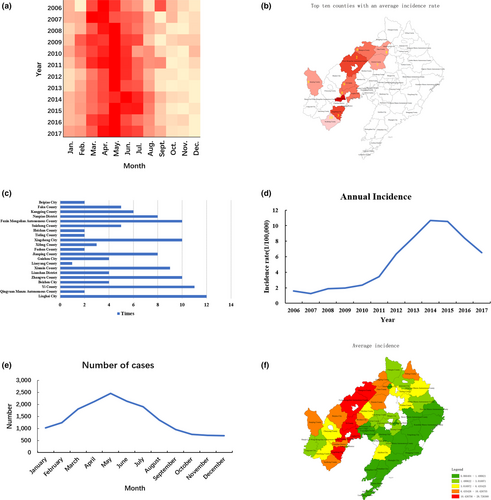
The Liaoning Province counties with the top 10 average incidence rates were as follows: Nanpiao District, Fuxin Mongolian Autonomous County, Xingcheng City, Zhangwu County, Linghai City, Yi County, Xinmin County, Faku County, Jianping County and Suizhong County (Table 2). The top 10 counties based on the average incidence rates were located in the northwestern part of Liaoning Province, adjacent to Inner Mongolia (Figure 1b). From 2006 to 2017, many of the aforementioned counties have appeared more than six times increase in 12 years in the top 10 list, especially Linghai City and Yi County have appeared more than 10 times (Figure 1c).
| Rank | Average incidence rate (1/100,000) | 2006 | 2007 | 2008 | 2009 | 2010 | 2011 | 2012 | 2013 | 2014 | 2015 | 2016 | 2017 |
|---|---|---|---|---|---|---|---|---|---|---|---|---|---|
| 1 | Nanpiao District (28.73) | Linghai City | Linghai City | Yi County | Fuxin Mongolian Autonomous County | Fuxin Mongolian Autonomous County | Zhangwu County | Nanpiao District | Nanpiao District | Nanpiao District | Nanpiao District | Yi County | Xinmin County |
| 2 | Fuxin Mongolian Autonomous County (21.30) | Qingyuan Manzu Autonomous County | Fushun County | Linghai City | Linghai City | Zhangwu County | Xingcheng City | Zhangwu County | Fuxin Mongolian Autonomous County | Xingcheng City | Yi County | Nanpiao District | Yi County |
| 3 | Xingcheng City (20.00) | Yi County | Qingyuan Manzu Autonomous County | Xingcheng City | Xingcheng City | Xinmin County | Fuxin Mongolian Autonomous County | Xingcheng City | Xingcheng City | Fuxin Mongolian Autonomous County | Xingcheng City | Faku County | Linghai City |
| 4 | Zhangwu County (18.24) | Beizhen City | Lianshan District | Gaizhou City | Zhangwu County | Yi County | Nanpiao District | Fuxin Mongolian Autonomous County | Linghai City | Linghai City | Fuxin Mongolian Autonomous County | Fuxin Mongolian Autonomous County | Nanpiao District |
| 5 | Linghai City (17.94) | Zhangwu County | Xifeng County | Beizhen City | Yi County | Jianping County | Jianping County | Linghai City | Zhangwu County | Suizhong County | Linghai City | Xinmin County | Faku County |
| 6 | Yi County (17.50) | Lianshan District | Xingcheng City | Xifeng County | Lianshan District | Nanpiao District | Linghai City | Kangping County | Yi County | Jianping County | Zhangwu County | Beipiao City | Zhangwu County |
| 7 | Xinmin County (10.43) | Xinmin County | Xinmin County | Fushun County | Beizhen City | Linghai City | Kangping County | Yi County | Suizhong County | Yi County | Faku County | Zhangwu County | Fuxin Mongolian Autonomous County |
| 8 | Faku County (10.20) | Liaoyang County | Gaizhou City | Heishan County | Jianping County | Lianshan District | Faku County | Xinmin County | Xinmin County | Zhangwu County | Jianping County | Linghai City | Beipiao City |
| 9 | Jianping County (9.88) | Gaizhou City | Tieling County | Suizhong County | Gaizhou City | Xifeng County | Beizhen City | Jianping County | Kangping County | Heishan County | Suizhong County | Kangping County | Xingcheng City |
| 10 | Suizhong County (8.49) | Jianping County | Yi County | Fuxin Mongolian Autonomous County | Xinmin County | Xingcheng City | Xinmin County | Suizhong County | Jianping County | Faku County | Kangping County | Tieling County | Kangping County |
The analysis of incidence rates from 2006 to 2017 revealed that the incidence rate decreased in 2007 then rose and peaked in 2015, and then declined (Figure 1d). Analysing the incidence rates in different months, it rose from January, peaked in May and then began to decrease, which is consistent with the higher incidence of brucellosis in the spring (Figure 1e). From the choropleth map, the cities in the north-west part of Liaoning such as Fuxin City, Jinzhou City and Huludao City have relatively high-incidence rates, and interestingly, these cities are adjacent to Inner Mongolia (Figure 1f).
According to the statistics of the Chinese database, in the past 12 years (from 2006 to 2017), the number of cattle and sheep in Liaoning Province increased from 2006, but the cattle number decreased in 2008 ,2014 and 2017, and the sheep number decreases since 2016. The analysis found that the cattle and sheep number was positively correlated with the case number, and the correlation of sheep number was higher than that of cattle number (Figure 2).
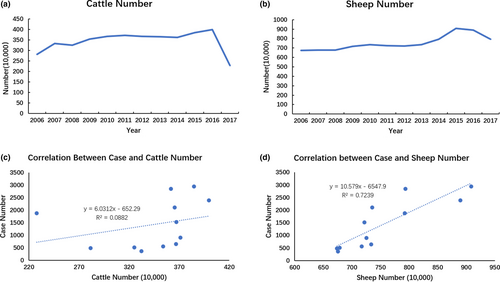
In 2006, the incidence rate of brucellosis in Liaoning Province was at a lower stage. Since 2007, the incidence rate of Xingcheng City, Yi county, Fuxin Mongolian Autonomous County and Zhangwu County started to rise, especially in Fuxin Mongolian Autonomous County. From 2007 to 2015, it began to rise in the surrounding counties with high-incidence rates. During this period, the incidence rate in the northwestern part of Liaoning Province increased rapidly, while it remained relatively stable in the southeastern region. From 2016, the incidence rates in the northwestern region began to decrease. This situation was in line with the total incidence rate in Liaoning Province which increased between 2004 and 2015 and then decreased in 2016 (Figure 3; Table S3).
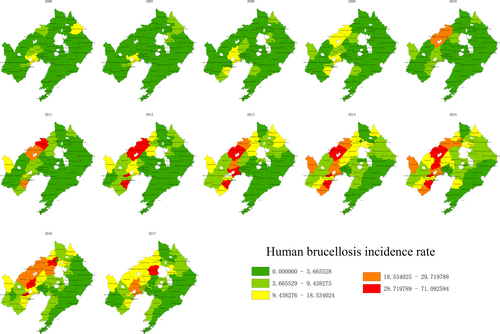
The Bayesian model was processed using the WinBUGS software. The model processed two chains. After a total of 15,000 iterations, the model tended to converge. After the model converged, it iterated 20,000 times for parameter estimation. The convergence of the model was determined by the Gelman–Rubin statistic. The convergence of the model was judged by comparing the variance between the chains and the variance within the chains (Figure 4).
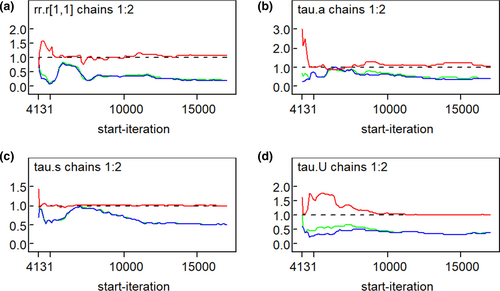
 ), (c) is the variance of spatially variable components (
), (c) is the variance of spatially variable components ( ), and (d) is the variance of time-variant components (
), and (d) is the variance of time-variant components ( ), where the green line represents the intrachain variance and the blue line represents the parameter to be estimated. The variance between the chains, the red line indicates the ratio of the variances. The ratio close to 1 indicates that the two chain iteration sequences are close, and the model convergence is good and is generally stable
), where the green line represents the intrachain variance and the blue line represents the parameter to be estimated. The variance between the chains, the red line indicates the ratio of the variances. The ratio close to 1 indicates that the two chain iteration sequences are close, and the model convergence is good and is generally stableThe disease risks of hot-spot and sub-hot-spot counties were higher than the average risk of the entire study area. In contrast, the disease risk of the cold-spot and sub-cold-spot counties was lower than the entire study area. The disease risk of other counties remained relatively convergent with the average risk of disease in the study area. All regions of the entire study area were stable counties with roughly the same disease risk. And compared with all regions, the county in northern Liaoning Province has relatively higher disease risk (Figure 5a,b; Table S4). The overall time variation trend in the estimated results of the model was calculated from the model: exp (b0t* + vt), which described the change of the overall risk of disease in Liaoning Province over time from 2006 to 2017 (Figure 5c). The risk of brucellosis in Liaoning Province decreased from 2006 to 2016, only increased slightly in 2011 and then again increased significantly from 2016 to 2017. Among them, the parameter of the average time trend coefficient b0 was estimated to be −0.0487, indicating that the average change of disease risk in the two adjacent years was exp(b0), that is the disease risk in the latter year was about 0.95 times than before. Therefore, the overall disease risk in Liaoning Province showed a downward trend in 12 years, but the downward trend was very slow. It can be seen from Figure 5d that the incidence risk of Ganjingzi District, Lushunkou District and Jinzhou District had a relatively fast downward trend compared to the overall risk. The downward trend of incidence risk in the other areas of Liaoning Province was consistent with the overall decreasing trend.
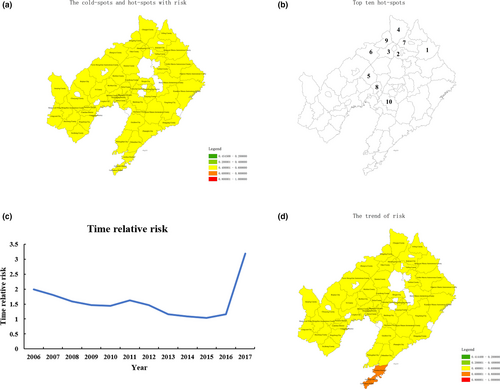
4 DISCUSSION
Brucellosis is a zoonotic bacterial disease caused by Brucella and a legally reported Class B infectious disease in China (Zhang, Mo, Song, & Fan, 2012). It can be transmitted to humans from host animals (such as cattle, sheep, goats and pigs) by direct contact with infected animals or by ingestion of untreated animal products (Pappas et al., 2006). The clinical manifestations of brucellosis are not obvious and often neglected; therefore, many patients have persistent infection. Due to the high rate of early diagnosis failure of human brucellosis and the residuals of infected patients are severely disabled, it has attracted much attention. Therefore, we analysed the existing disease data and used Bayesian space–time model to analyse the incidence of brucellosis. The study found that the risk of brucellosis had a hot-spot county and four sub-cold-spot counties and declined slowly with time without an obvious trend. Besides, the declining trend of disease risk in two sub-hot-spot counties was faster than the overall trend, whereas in other counties, the trend was similar to the overall trend.
According to the statistical analysis of the data, the incidence rate of male engaged in animal husbandry was relatively high, which was roughly the same as that in China. At present, the overall breeding mode in Liaoning Province is mainly family farming, which is basically semi-farming and semi-herding. In households that rely on animal husbandry as their economic source, adult males usually serve as the main labour force. They come in frequent contact with the livestock. If the livestock has been infected and did not have obvious symptoms, these people have a high risk of contracting brucellosis.
There is a high incidence of brucellosis in the spring and summer, which may be related to many factors, such as breeding operations, precipitation, animal movement, sunshine levels and wind speed (Huang et al., 2018). In spring, temperatures rise and precipitation increases, making the climate conducive to bacterial growth. Furthermore, the animals move around more in spring, further increasing the risk of infection in sensitive animals (Zhao et al., 2019). With the rising temperatures, farmers and herdsmen shear sheep and come in close contact with the livestock, which puts them at high risk of infection. In addition, the number of sheep breeding increases in summer, and the probability of the disease is increased through the delivery and contact with aborted stillbirth. In summer, the demand for mutton increases further exposing the farmers involved in animal husbandry. All of these factors put the people involved at a high risk of infection which accelerates the spread of Brucella.
The farmers usually have a yard in their homes and may have free space to raise animals, such as pigs and sheep. They also have cattle to help with cultivation of the land. Many farmers may lack the knowledge about brucellosis. If the infected animals that are bred and used are not quarantined promptly, then the farmers may get infected with the disease. The unemployed people had the second highest incidence rate. The potential reason is that the clinical symptoms of brucellosis are not obvious and some people may think of it as just a flu and ignored it. After a period of time, the clinical symptoms of the brucellosis affected them and they lose the ability to work.
From the overall analysis, the incidence in Liaoning Province rose since 2006, reached a peak in 2015 and began to decrease from 2016. This is roughly consistent with the high-incidence rate in China's history (which occurred in 2014; Lai et al., 2017). According to the official annual data released by the National Bureau of Statistics, the trend of the livestock industry may have a certain relationship with the incidence of brucellosis. Because brucellosis causes abortion in animals, it affects the farming situation in the livestock industry (Corbel, 1997; Earhart et al., 2009; Sohn et al., 2003). People who get exposed to sick cattle and sheep can get infected with Brucella. Therefore, the incidence of cattle and sheep disease is higher when the incidence rate is high, and the disease will reduce the production of cattle and sheep. This may be the reason of the high-incidence rate and the drop in the production of cattle and sheep in 2015. Liaoning Province started to carry out vaccination against brucellosis in cattle and sheep in 2016. Prior to this, cities with severe brucellosis had already been immunized. In 2016, the number of sheep immunizations in Liaoning Province was 2.07 times that in 2015 (975.5/470.5), and the number of immunizations in cattle was 2.5 times that in 2015 (122.1/48.87; Yang, 2018). And the disease control department and animal disease control department implement the ‘National Brucellosis Control Plan (2016–2020)’. Strengthen the implementation of the Brucella immunization programme for cattle and sheep, so that the number of cattle and sheep suffering from brucellosis is reduced, which leads to a lower probability of human infection with Brucella (Wang, Sun, et al., 2018; Wang, Yu, et al., 2018). The incidence rate began to decrease in 2016, which may be related to the implementation of the Liaoning provincial livestock immunization programme.
From the analysis of geographical location, the Western part of the Liaoning Province had a high-incidence area of brucellosis, which gradually spreads to the central and eastern regions. The Western area of Liaoning Province is adjacent to Inner Mongolia. The incidence rate of brucellosis is high in Inner Mongolia autonomous, and the animals traded from there to Liaoning Province are not quarantined. This may result in people buying and raising the infected animals. The spread of the disease from west to east may be related to the livestock trading routes in Liaoning Province (from west to east). In addition, the significant increase in the incidence of brucellosis attracted the attention of the relevant departments in the areas with high incidence of brucellosis, and they promoted better awareness in livestock practitioners and healthcare professionals about clinical diagnosis and transmission of brucellosis. Therefore, there are effective prevention and control methods for the occurrence and spread of brucellosis, an important reason that may have contributed to the decrease in brucellosis incidence in high-incidence areas.
In this study, the Bayesian space–time model was used to explore the incidence of brucellosis in Liaoning Province from 2006 to 2017. It was found that the overall incidence of brucellosis in Liaoning Province showed a downward trend, but the decline was slow and may relate to the national measures. All regions of the entire study area were stable counties, but the county in northern Liaoning Province has relatively higher disease risk. Areas with a higher risk of disease may be associated with the production activities of local residents, such as cashmere goats and small-tailed cold sheep, as well as the trade flows in livestock markets. According to the results of the Bayesian space–time model, we predicted that in recent years, the incidence of human brucellosis in Liaoning Province is declining. Besides, the counties like Ganjingzi District, Lushunkou District and Jinzhou District, the downward trend will be faster than other districts.
The current public health system in rural China consists of three levels: county-level centres for disease control and prevention, hospitals, and township hospitals and village clinics. In most rural areas of China, the basic control units of brucellosis are county-level centres and hospitals, and most patients live far away from these units (Chen et al., 2016). In addition, some farmers and herdsmen do not have enough knowledge about brucellosis, so they do not go to see a doctor or fail to see a doctor at the right time. The signs and symptoms of human brucellosis are very atypical, and if local medical staff does not know enough about brucellosis, it may result in misdiagnosis and missed diagnosis. In the future, the government and relevant medical institutions should strengthen public awareness and education of brucellosis knowledge among the people who work or live in close contact with livestock and improve the diagnosis level of brucellosis among grassroots medical and health personnel. In addition, animal husbandry departments should also strengthen the supervision of livestock brucellosis immunity and incidence.
5 CONCLUSIONS
In recent years, the incidence rate of brucellosis has stayed at a high level in Liaoning Province. In this study, we analysed the reasons based on patient conditions and agricultural data. We discovered that males of age 45–54 years had a high-incidence rate, and most of them were farmers and unemployed people. In addition, this disease had a high-incidence period in spring and summer. Moreover, we analysed data using the Bayesian space–time model to predict the incidence rate of brucellosis. We found that the risk of incidence in entire study areas is stable, all areas were stable counties. And, the incidence rate has a general declining trend in the whole of Liaoning Province, especially the rates in Ganjingzi District, Lushunkou District and Jinzhou District are declining sharply compared to the trend in the entire province. In general, brucellosis as a health issue has caused many problems for the residents of Liaoning. Therefore, it is necessary to analyse the reasons of high-incidence rate. By analysing where the highest incidence areas are and how the trends are changing, we can predict which county the prevention and intervention measures should target. This will enable the necessary authorities to ensure that there is an adequate supply of health programmes and other types of support.
ACKNOWLEDGEMENTS
This work was supported by National Key Research and Development Program Projects of China (2017YFD0500305, 2017YFD0500901), the National Key Program for Infectious Disease of China (2018ZX10101002-002), the State Key Program of National Natural Science of China (U1808202), NSFC International (regional) cooperation and exchange program (31961143024) and Major science and technology projects of Inner Mongolia of China (2019ZD06).
CONFLICT OF INTEREST
The authors declare no competing interests.
AUTHOR CONTRIBUTIONS
Z. Chen, Y. Liao and D. Wang conceived and designed the study. Q. Zhang, C. Li, Y. Li, H. Zhang and X. Han participated in data collection and analysis. Qi Zhang and Z. Chen drafted and revised the manuscript.
ETHICAL STATEMENT
The authors confirm that the ethical policies of the journal, as noted on the journal's author guidelines page, have been adhered to and the appropriate ethical review committee approval has been received.
Open Research
DATA AVAILABILITY STATEMENT
The data that support the findings of this study are available from the National Notifiable Disease Surveillance System but restrictions apply to the availability of these data, which were used under licence for the current study, and so are not publicly available. Data are, however, available from the authors upon reasonable request and with permission of the Plague and Brucellosis Prevention and Control Base.



